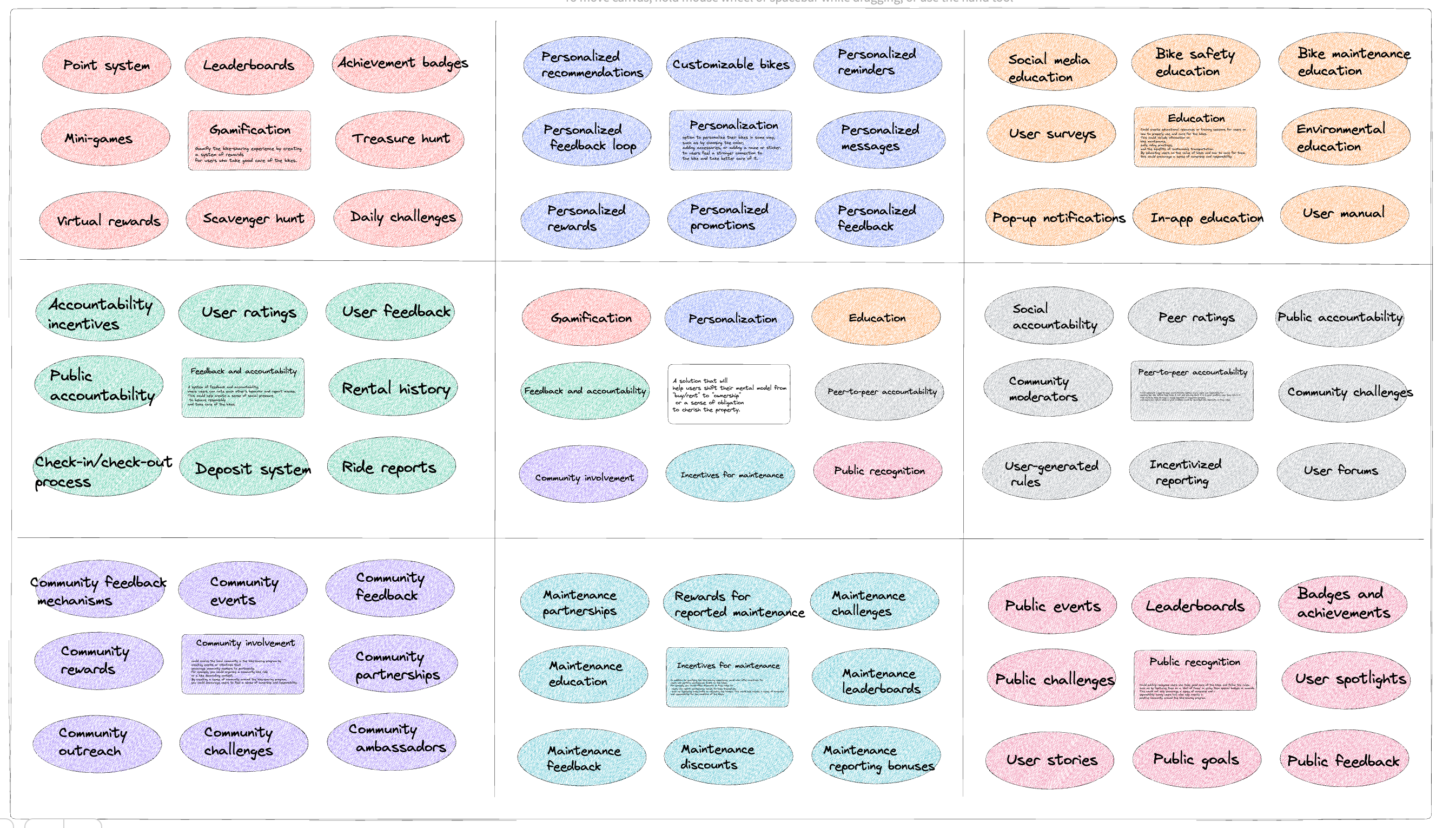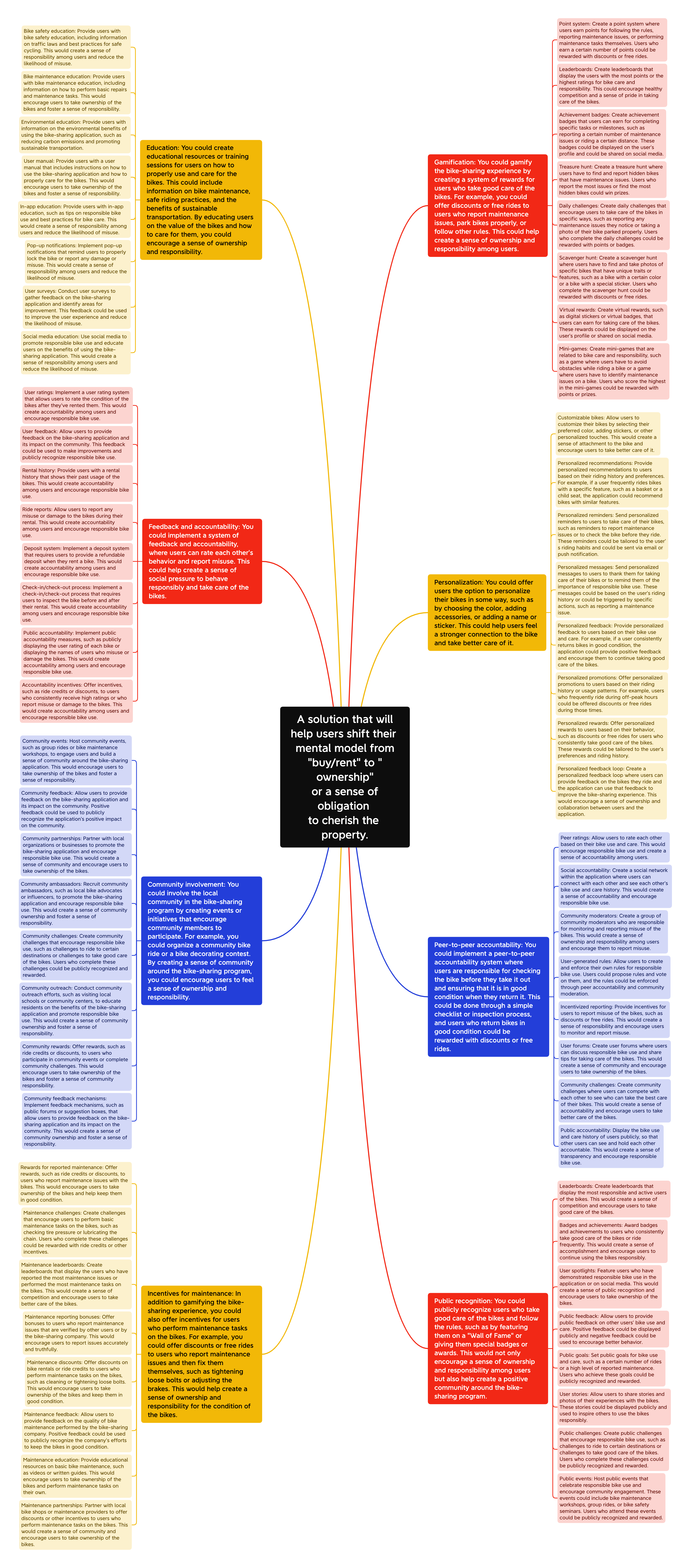Lotus blossom - mentally shift - "ownership"
Context
My current idea is to build a concept similar to "bookcrossing" but for bikes.
Design challenge
To find a solution that will help users shift their mental model from "buy/rent" to "ownership" or a sense of obligation to cherish the property.
The onwnership in this context,it refers to the sense of responsibility that users feel towards the bikes they use. Instead of treating the bikes as disposable or temporary, users should feel a sense of ownership towards them, as if they are their own personal property.
Outcomes
draft idea
Link
ideas with the help from AI

- Some idea for building the whole process of the application
idea - 1: Registration Users can register on the platform to become members and access the bike-sharing service. The registration process will collect user information and create a user profile.
idea - 2: Bike Availability: The bike-sharing platform will work with bike suppliers to have a pool of bikes available for rent. Bike owners can also choose to register their unused bikes on the platform for renting purposes.
idea - 3: Bike Selection The platform will offer a range of bikes for users to choose from based on their personal preferences, needs, and bike availability. Users can select a bike and make a reservation using the platform.
idea - 4: Pick-up Users can pick up the bike from a designated location using a code provided by the platform. They will then use the bike as they need for the rental period.
idea - 5: Return Users will return the bike to a designated location at the end of the rental period. They will need to check the bike's condition and confirm its return status through the platform.
idea - 6: Maintenance
The bike-sharing platform will offer incentives for users to maintain the bikes in good condition. Users can report any issues they encounter with the bike during the rental period, and the platform will arrange for maintenance or repairs as necessary.
idea - 7: Ownership Awareness The bike-sharing platform will use gamification, personalization, peer-to-peer accountability, public recognition, community involvement, feedback, and education to encourage a sense of ownership and responsibility among users. Users can participate in community events, share their bike usage stories, and receive rewards for proper bike usage and maintenance.
Example story:
1.Meet Lily, a college student who wants to rent a bike to get around campus. Lily heard about the new bike-sharing platform in town and decided to give it a try. She registered on the platform and created her profile, indicating her preferences for a bike with a basket and a comfortable seat.
2.Lily browsed through the available bikes and selected a blue bike with white stripes that had a unique ID number. The bike had a history of being owned by a previous user who added a fun memory of their bike ride to the beach. Lily was excited to create her own memories with this bike.
3.She picked up the bike from a designated location using a code provided by the platform and rode it to her class. During her ride, she received notifications on bike maintenance tips and educational tidbits about bike safety.
4.After using the bike for a few days, Lily returned it to the designated location and confirmed its return status through the platform. She received points for proper bike usage and maintenance, which she could redeem for rewards like free bike rentals or a discount on a new bike.
5.Lily felt proud of her proper bike usage and maintenance and shared her story on the bike-sharing platform's community page. She received public recognition for her contribution to the platform's mission to encourage a sense of ownership and responsibility among users.
6.The bike-sharing platform's approach to ownership awareness through gamification, personalization, peer-to-peer accountability, public recognition, community involvement, feedback, and education made Lily's bike rental experience fun, educational, and rewarding.
Summary
The process for using the bike-sharing application begins with individuals who own bikes that they are not using, leaving them at designated locations. Bike suppliers can also contribute their own bikes to be rented out. Each bike is given a unique ID that allows for personalization and attachment to the bike's history. Users can browse the available bikes on the app and select one that suits their needs.
To incentivize proper maintenance and encourage a sense of ownership, users are given rewards for taking care of the bikes they rent. These rewards can range from discounts on future rentals to public recognition within the community.
In order to foster a sense of community and peer-to-peer accountability, the app also includes a self-monitoring mechanism. Users are encouraged to report any damage or misuse of bikes they come across, and those who report issues are rewarded. Additionally, community events and challenges are held to promote healthy competition and engagement.
The app also includes educational features such as a knowledge base of biking tips and resources, and users can receive personalized recommendations based on their interests and previous rentals.
One example of a use case for the bike-sharing app is for tourists visiting a new city. They can quickly and easily rent a bike, customized to their preferences and needs, to explore the city at their leisure. The app provides recommendations for bike-friendly routes and sights, as well as tips for safely navigating the city's streets.
Some or all of the text in this document was generated with the assistance of ChatGPT or other grammar checking tools